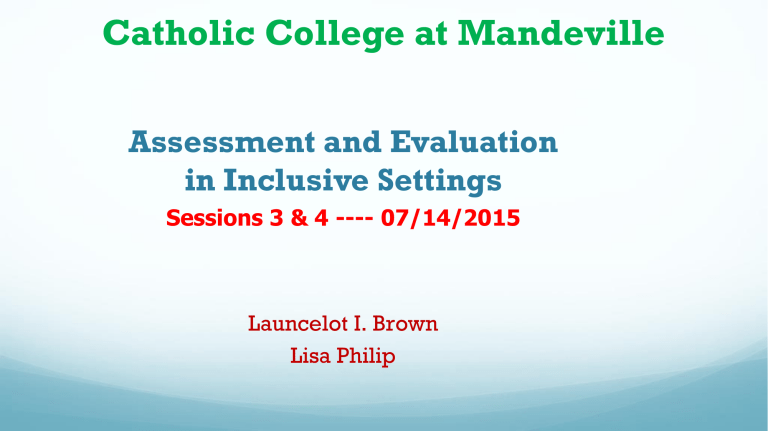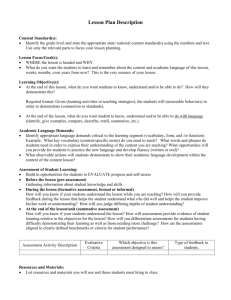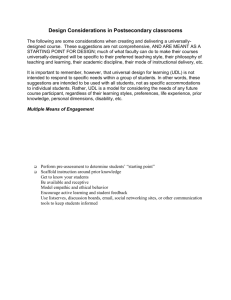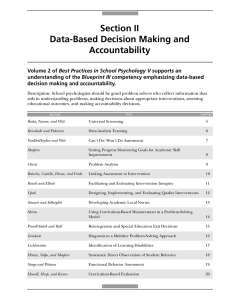Assessment and Evaluation in Inclusive Settings

Catholic College at Mandeville
Assessment and Evaluation in Inclusive Settings
Sessions 3 & 4 ---- 07/14/2015
Launcelot I. Brown
Lisa Philip
Assessment and Evaluation in Inclusive Settings
Objectives:
Discuss how regular ed. teachers contribute to assessment process
Examine alternate assessments for students with cognitive disabilities
Define curriculum-based assessment
Construct probes of academic, prerequisite skills, content-area knowledge, and independent learning skills
Use curriculum-based assessments to make special ed. decisions
Use performance-based and portfolio assessments for students with disabilities
Assessment and Decision Making
Six Areas of Decision Making
1) Screening
Decision about whether a student’s performance differs enough from peers to merit further testing
2) Diagnosis
Decision about eligibility for special education services
3) Program Placement
Decision involving the setting in which a student’s special education services will take place
Assessment and Decision Making
Six Areas of Decision Making
4) Curriculum Placement
Decision involving the level at which to begin instruction for the student
5) Instructional Evaluation
Decision involving whether to continue or change instructional procedures
6) Programme Evaluation
Decision involving whether a student’s special education program should be terminated, continued as is, or modified
Information Sources for Programming
High-Stakes Achievement Tests
Standardized Achievement Tests
~ Group Administered
~ Individually Administered
Psychological Tests
Alternate Assessments
Curriculum-Based Assessments
Curriculum-Based Assessment (CBA)
What it is:
A procedure for determining the instructional needs of a student based on the student’s ongoing performance within existing course content. (Gilking & Havertape,
1981, p.55)
Why CBA
It complies with the procedural requirements for meeting the learning needs of Individual with Disabilities.
It is efficient.
It is a valid, reliable basis for making decisions.
It can be used to make various kinds of decisions (e.g., screening and programme effectiveness).
It increases students achievement.
Curriculum-Based Assessments
Effective alternative to standardized tests
Measure based on what is taught in class
Match between what is taught and what is tested
Measure performance over time
Compare students by class, school, or district
Allow teachers to adjust instruction
Curriculum-Based Assessment:
How conducted?
Direct observation and analysis of the learning environment.
Analysis of the processes students use to approach tasks
Examination of students’ products
Controlling and arranging tasks for students
Conducting CBA
Three Suggestions
1) Identify Information in Classroom
2) Select Representative Skills, Not All Skills
3) Keep Level and Scoring Consistent
~ Probes of reading skills
~ Probes of written expression skills
~ Probes of math skills
Curriculum-Based Assessment
An advantage of using CBA as a form of measurement of student performance is:
It allows teachers to evaluate the effectiveness of the instruction they provide to the students, but even more so to individual students
Instructional Diagnosos
An assessment practice used to identify the extent to which a student’s poor performance is as a result of poor instruction and to indicate possible remedies for the problem.
It is a systematic analysis of the instruction.
A systematic analysis of what is required of the student.
A systematic analysis of the components of the task.
The last point requires the teacher to break complex tasks into their component skills – TASK ANALYSIS.
Evaluating Student Learning
Ways that students are usually evaluated (testing, grading) can be problematic
Current climate of expectations and accountability complicates the process
Accommodations must assist students without compromising their ability to meet standards on high-stakes tests
Making Accomodations for Classroom Tests
Accomodations Before the Test
Prepare a Study Guide
Give a Practice Test
Offer Tutoring
Teach Test-Taking Skills
Demonstrate Memorization
Techniques
Making Accomodations for Classroom Tests
Accomodations Before the Test
Teach Students to Organize
Materials
Demonstrate a Rehearsal Strategy
Show How to Take Essay Tests
Modify Your Test Construction
Making Accomodations for Classroom Tests
Accomodations During the Test
Use Alternative Forms of Questions
Use Alternative Ways to Administer
Tests
Use Alternative Test Sites
Making Accomodations for Classroom Tests
Accomodations After the Test
Change Letter or Number Grades
Change Grading Criteria
Use Alternatives to Letter or Number
Grades (such as Competency Checklist)
Performance-Based and Portfolio Assessments
Measure learning process rather than focusing only on learning product.
Benefits of Performance-Based
Assessments
Involve authentic learning tasks (those presented in real-world contexts that have real-world outcomes)
Allow students to demonstrate knowledge without relying on reading and writing
Are not subject to time restraints of traditional tests
Help make connections to real life and real skills
Problems with Performance-Based
Assessments
Have difficulty making connections between tasks and realworld issues
Lack important preskills for problem solving
Need problem-solving taught directly
Need demonstrations of tasks
Benefits of Portfolio Assessments
Offer purposeful collection of work to measure effort, progress, and achievement
Contain observable evidence
(though may or may not reflect authentic tasks)
Assist in evaluation of progress toward IEP goals
Emphasize products rather than test scores
Allow for student self-evaluation
Problems with Portfolio Assessments
Need help in understanding how to select work
Need help in understanding how to evaluate work








